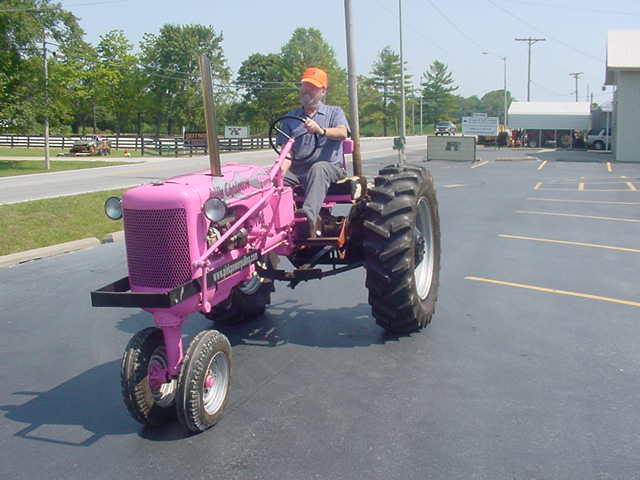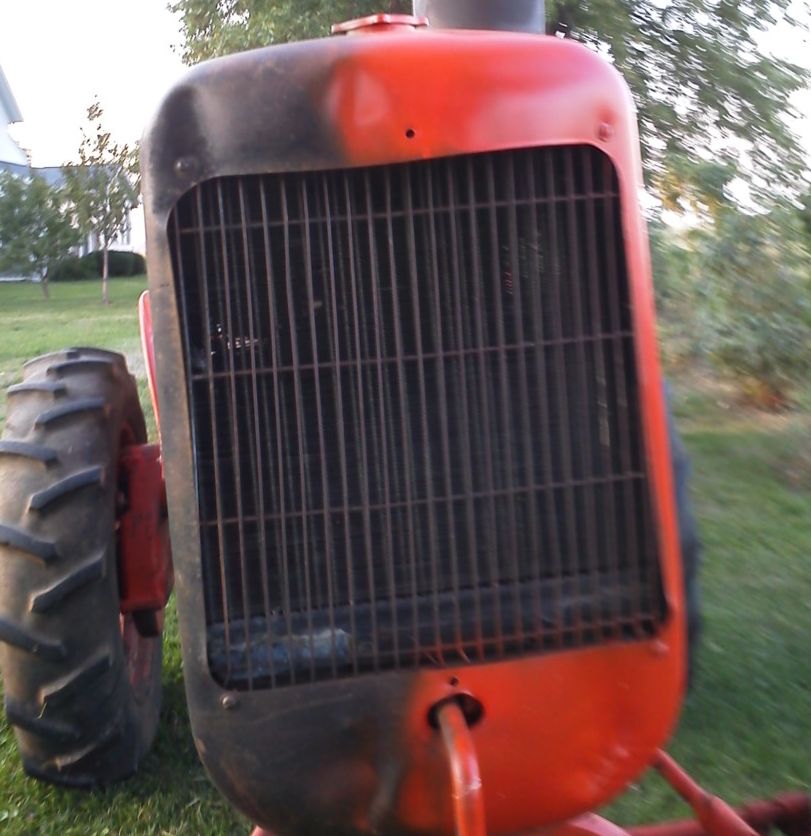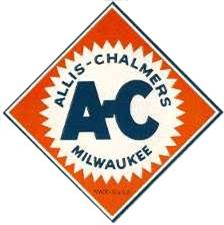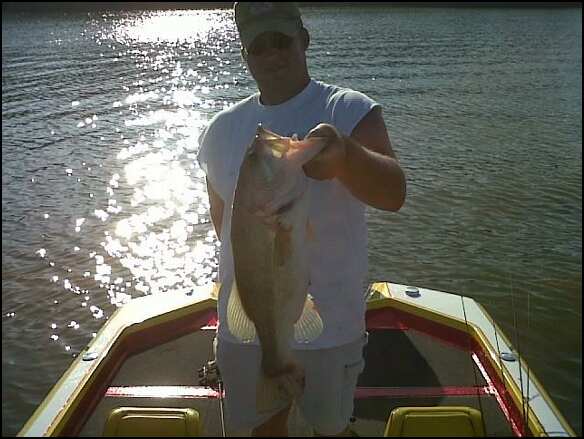| Author |
 Topic Search Topic Search  Topic Options Topic Options
|
R.W 
Orange Level

Joined: 31 Dec 2010
Location: Swanton, OH
Points: 2975
|
 Post Options Post Options
 Thanks(0) Thanks(0)
 Quote Quote  Reply Reply
 Topic: Narrow Front vs Wide Front? Topic: Narrow Front vs Wide Front?
Posted: 16 Jan 2011 at 9:17am |
I like wide fronts for makeing hay so you dont crush as mouch crop, but other that safty, stubitially. But for small tractors i would perfere Narrow fronts you can put a tractor anywhere , you can turn sharp, and i always thought they made the tractor like a tank because they were one piece and not a clumsy wide front in front. So what do you perfer on small tractores wide or narrow?
Edited by R.W - 16 Jan 2011 at 11:06am
|
|
In Search Of: 1958 Allis Chalmers D17 Diesel serial #9643D
|
 |
|
Sponsored Links
|
|
 |
DSeries4 
Orange Level


Joined: 12 Sep 2009
Location: Ontario, Canada
Points: 7205
|
 Post Options Post Options
 Thanks(0) Thanks(0)
 Quote Quote  Reply Reply
 Posted: 16 Jan 2011 at 10:12am Posted: 16 Jan 2011 at 10:12am |
|
Definitely wide front for safety reasons. Much more stability, especially when crossing the side of a hill.
|
|
'49 G, '54 WD45, '55 CA, '56 WD45D, '57 WD45, '58 D14, '59 D14, '60 D14, '61 D15D, '66 D15II, '66 D21II, '67 D17IV, '67 D17IVD, '67 190XTD, '73 620, '76 185, '77 175, '84 8030, '85 6080
|
 |
Burgie 
Orange Level


Joined: 13 Sep 2009
Location: Scottsburg, IN
Points: 1192
|
 Post Options Post Options
 Thanks(0) Thanks(0)
 Quote Quote  Reply Reply
 Posted: 16 Jan 2011 at 10:32am Posted: 16 Jan 2011 at 10:32am |
|
Just depends on what the job is.
|
|
"Burgie"
|
 |
Dick L 
Orange Level


Joined: 12 Sep 2009
Location: Edon Ohio
Points: 5082
|
 Post Options Post Options
 Thanks(0) Thanks(0)
 Quote Quote  Reply Reply
 Posted: 16 Jan 2011 at 11:19am Posted: 16 Jan 2011 at 11:19am |
On a side hill the small tractors are not really more safe from tipping.
|
 |
Denis in MI 
Orange Level

Joined: 15 Sep 2009
Location: Norvell, MI
Points: 832
|
 Post Options Post Options
 Thanks(0) Thanks(0)
 Quote Quote  Reply Reply
 Posted: 16 Jan 2011 at 11:28am Posted: 16 Jan 2011 at 11:28am |
|
you are right Dick L, a wide front just makes you feel safer on a side hill, but any tractor will turn over don't anybody fool yourself on that.
|
|
1938 B, 1945 B, 1941 IB, 1949 C, 2 1938 WCs, 3 1950 WDs, 1951 WD, 2 1955 WD45, 1957 D-14
|
 |
omahagreg 
Orange Level Access

Joined: 11 Sep 2009
Location: Omaha, Nebraska
Points: 2799
|
 Post Options Post Options
 Thanks(0) Thanks(0)
 Quote Quote  Reply Reply
 Posted: 16 Jan 2011 at 11:46am Posted: 16 Jan 2011 at 11:46am |
|
Dad and Grandpa farmed in gumbo. Could not use a narrow front, as it would get packed in there and then you were plowing, not driving anymore.
|
|
Greg Kroeker
1950 WD with wide front and Freeman trip loader
|
 |
LionelinKY 
Orange Level

Joined: 12 Sep 2009
Location: Radcliff,KY
Points: 695
|
 Post Options Post Options
 Thanks(0) Thanks(0)
 Quote Quote  Reply Reply
 Posted: 16 Jan 2011 at 11:48am Posted: 16 Jan 2011 at 11:48am |
|
I consider myself old school so I believe that you can't beat an old NF as a cultivator tractor though you'd never get done with today's acreages. They also work the best come fall for getting all the equipment squared away backed into the old machinery shed. Other than those 2 tasks, I'll go with the WF for increased stability. Notice I didn't say guaranteed stability.
|
|
"My name is Lionel and I'm an Allisoholic"
|
 |
Eldon (WA) 
Orange Level


Joined: 11 Sep 2009
Location: Spokane, WA
Points: 7765
|
 Post Options Post Options
 Thanks(0) Thanks(0)
 Quote Quote  Reply Reply
 Posted: 16 Jan 2011 at 12:18pm Posted: 16 Jan 2011 at 12:18pm |
OK, I'll dissagree with Dick.
If you are crossing a sidehill and your narrow front drops in a badger hole, the front end drops 10" then pops out of the hole and throws the whole balance of the tractor to the downhill side. It probably jerks the steering wheel right out of your hand in the process, adding to the unsafe condition.
When a wide front encounters the same hole, the front end only drops 1/2 the distance or 5" and you barely feel the effect...steering is minimally effected. Also most tractors with wide fronts have stops built in so they only pivot so far....unfortunately the little B isn't one of them. Check out the Wd, WD45 and on up, they can all only pivot a small amount. I've had a lot of them hanging on one front wheel when going thru a ditch.
Probably the biggest advantage to the wide front in this situation is the front wheel acts as a scout to check out the terrain before the rear wheel finds it. I have found this out countless times when I am out brushhogging in tall grass...if that downhill front tire drops, I stop and check out the situation before proceeding! In many cases if I was running a narrow front tractor, I would have rolled it because I would not have had a warning of how far the rear wheel was going to drop.
|
|
ALLIS EXPRESS!
This year:
|
 |
Rick 
Orange Level


Joined: 11 Sep 2009
Location: Jonesburg,Mo.
Points: 3641
|
 Post Options Post Options
 Thanks(0) Thanks(0)
 Quote Quote  Reply Reply
 Posted: 16 Jan 2011 at 12:41pm Posted: 16 Jan 2011 at 12:41pm |
|
I'll have to agree with Eldon. A narrow front end is great for many reasons...fitting more tractors in a shed/barn easier,for use as a plowing,discing,brush hogging,etc. tractor on flat to gently rolling ground. However,if I'm logging or dragging firewood tops through the hills and hollows like I do,then you'll only see me doing so with a wide front tractor for safety reasons. Don't get me wrong,you can overturn a wide front end tractor just the same,but I think that's because some people get a little brave knowing this. That's why I always have and always will have respect for machinery. It has no feelings! Rick
|
 |
Lester 
Orange Level

Joined: 08 Jan 2010
Location: Indiana
Points: 518
|
 Post Options Post Options
 Thanks(0) Thanks(0)
 Quote Quote  Reply Reply
 Posted: 16 Jan 2011 at 12:42pm Posted: 16 Jan 2011 at 12:42pm |
|
Wide front are a lot safer, ride smoother, steer easier, go much farther in mud and snow.Narrow front are okay for parking on a lawn or shed ,not as good for real work in field.
|
 |
darrel in ND 
Orange Level


Joined: 22 Nov 2009
Location: Hebron, ND
Points: 8588
|
 Post Options Post Options
 Thanks(0) Thanks(0)
 Quote Quote  Reply Reply
 Posted: 16 Jan 2011 at 1:03pm Posted: 16 Jan 2011 at 1:03pm |
|
I'll take a wide front over a narrow front, I think they have a safety advantage, and in my own opinion, I just like the looks of em better, Darrel
|
 |
DaveKamp 
Orange Level Access


Joined: 12 Apr 2010
Location: LeClaire, Ia
Points: 5642
|
 Post Options Post Options
 Thanks(0) Thanks(0)
 Quote Quote  Reply Reply
 Posted: 16 Jan 2011 at 1:06pm Posted: 16 Jan 2011 at 1:06pm |
|
Narrow front tractors have historically been referred to as 'row-crop' tractors for that reason. With the narrowing of rows and virtual elimination of mid-season cultivation for large field crops, the need for NF as field tractors has all but gone... some truck-farming operations still benefit from row-crop clearance.
Geometrically, 3 points defines a plane... so in ideal circumstances, with proper weight on the wheels, a NF tractor SHOULDN'T be any less-safe than a WF...
(notice I didn't say 'safer'... I said 'less safe').
Tractors drive in places where the world ain't always flat, and they don't have a center of gravity that is particularly low, therefore, they roll over. The tractor I prefer, is the one that I'm not on when it rolls. The WORST tractor to be in, is one with a full, protective cab, upside down, in a full creek... with all doors and windows blocked.
The tractor to collect, if you have limited space and budget, is the NF, because they 1) Park very close and 2) due to demand, are frequently less expensive than a WF. Finally, 3) you can walk around or stand next to the engine, without tripping over the front axle... so nicer to work on in the shop.
They're like women- come in all styles and colors, and sooner or later, every one of 'em will somehow drive you crazy... but I'll take 'em ALL. Even GREEN tractors are fun to ride, just don't let your friends catch 'ya doin it!
|
 |
Don(MO) 
Orange Level

Joined: 12 Sep 2009
Location: Bates City MO.
Points: 6862
|
 Post Options Post Options
 Thanks(0) Thanks(0)
 Quote Quote  Reply Reply
 Posted: 16 Jan 2011 at 1:28pm Posted: 16 Jan 2011 at 1:28pm |
|
I'm not saying which is better WF or NF. I was working at a dealership years ago and saw a 460 Farmall go over sitting on flat ground, the setup guy was unloading a disc that was hooked to one side of the loader (tractor had a WF) and he lifted the disc up and backed away from the trailer and the tractor when over on it side. The guy jumped off just in time. They will all go over. Don
|
|
3 WD45's with power steering,G,D15 fork lift,D19, W-Speed Patrol, "A" Gleaner with a 330 corn head,"66" combine,roto-baler, and lots of Snap Coupler implements to make them work for their keep.
|
 |
DonBC 
Orange Level Access


Joined: 12 Sep 2009
Location: Courtenay, BC,
Points: 900
|
 Post Options Post Options
 Thanks(0) Thanks(0)
 Quote Quote  Reply Reply
 Posted: 16 Jan 2011 at 1:58pm Posted: 16 Jan 2011 at 1:58pm |
|
The stability issue is largely related to the centre of gravity(COG) and the point of rotation. At the rear of the tractor the point of rotation is one of the rear tires so a wider stance is more stable and more weight at the rear is also more stable. At the front end the point of rotation is the bottom of the front tires of a NF and the centre of the pivot pin on a WF. On flat ground the COG is directly above the pivot point of both types and the pivot point of a WF might be as little as 1/3 the distance to the COG than the pivot point of the NF. If the tractor is on a side slope the COG shifts to the low side of the pivot points. If you draw a straight line vertically down from the COG the COG is a lot further to the side of the pivot point of a NF than it is from the pivot point of a WF. If the length of this horizontal line is considered as a representation of the difference in overturning force it is easy to see graphically why the NF is not as stable as a WF. This becomes even more pronounced if you add a FEL and raise a loaded bucket above the normal COG of the tractor because it moves the combined COG even higher and makes the NF even more unstable. Sorry for the long post but it didn't seem as if some of the respondents understood how the location of the pivot with respect to the COG affects stability.
|
|
Jack of all trades, master of none
|
 |
Lester 
Orange Level

Joined: 08 Jan 2010
Location: Indiana
Points: 518
|
 Post Options Post Options
 Thanks(0) Thanks(0)
 Quote Quote  Reply Reply
 Posted: 16 Jan 2011 at 3:05pm Posted: 16 Jan 2011 at 3:05pm |
It is common knowledge to older farmers who were around a lot of rollovers in the 50s and early 60s before wide front ends were popular that the nfes rolled quicker, were harder to steer ''no powersteering'' and ruffer to ride on. Some only kept nfe on farm for a cornpicker.. Why dont the still make them if they were so great?
|
 |
Lars(wi) 
Orange Level Access


Joined: 14 Sep 2009
Location: Permian Basin
Points: 6678
|
 Post Options Post Options
 Thanks(0) Thanks(0)
 Quote Quote  Reply Reply
 Posted: 16 Jan 2011 at 3:59pm Posted: 16 Jan 2011 at 3:59pm |
|
I planted corn and cultivated with a narrow front Case 830 Comfort King diesel, worked great for me. also baled with same tractor untill the pto got weak.
|
|
I tried to follow the science, but it was not there. I then followed the money, and that’s where I found the science.
|
 |
BStone 
Orange Level


Joined: 15 Sep 2009
Location: Texas
Points: 2847
|
 Post Options Post Options
 Thanks(0) Thanks(0)
 Quote Quote  Reply Reply
 Posted: 16 Jan 2011 at 4:13pm Posted: 16 Jan 2011 at 4:13pm |
|
I think the NF are just as safe as the WF....if your on a very hard flat level surface and driving Real slow.Maybe they are good for steering in tight places in a building, but I don't buy are use a tractor just for that purpose.Other than a corn picker tractor I have no use foe them.I know some people like them so it's a buyers market where I live because you can't hardly give one away.BStone
|
 |
Matt (NEIA) 
Bronze Level

Joined: 20 Sep 2009
Location: Butler Co. IA
Points: 168
|
 Post Options Post Options
 Thanks(0) Thanks(0)
 Quote Quote  Reply Reply
 Posted: 16 Jan 2011 at 9:55pm Posted: 16 Jan 2011 at 9:55pm |
|
the narrow fronts witout power steering steer easier than a widefront also without power steering in my opinion, atleast they do with the ones i've operated
|
|
1955 WD-45 with factory PS
|
 |
Brian G. NY 
Orange Level


Joined: 12 Sep 2009
Location: 12194
Points: 2198
|
 Post Options Post Options
 Thanks(0) Thanks(0)
 Quote Quote  Reply Reply
 Posted: 16 Jan 2011 at 10:15pm Posted: 16 Jan 2011 at 10:15pm |
DonBC,
I'm not an engineer but I have a sense about things mechanical.
You explained why, as I've always said, the WFE has an advantage
on side hills.
Thank you.
|
 |
Tracy Martin TN 
Orange Level Access


Joined: 11 Sep 2009
Location: Gallatin,TN
Points: 10564
|
 Post Options Post Options
 Thanks(0) Thanks(0)
 Quote Quote  Reply Reply
 Posted: 16 Jan 2011 at 10:26pm Posted: 16 Jan 2011 at 10:26pm |
|
I like them both. Nothing prettier than a B on full steel, or a NF 170, wish I had both of them. Tracy Martin
Edited by Tracy Martin TN - 16 Jan 2011 at 10:27pm
|
 |
Chris (swIA) 
Orange Level


Joined: 13 Sep 2009
Location: Prescott, IA
Points: 319
|
 Post Options Post Options
 Thanks(0) Thanks(0)
 Quote Quote  Reply Reply
 Posted: 16 Jan 2011 at 10:34pm Posted: 16 Jan 2011 at 10:34pm |
Your stability triangle includes the 2 rear tires and the pivot of a wide front or the narrow front. DonBC is right that the center of gravity shifts a little with the wide front versus the narrow but it is a matter of an inch or 2 difference in tipping. most of the older wide fronts weren't built heavy enough to prevent a roll over once it starts, they would break off. I still think that it is a false sence of security and if your are running that close you are just asking for trouble down the road. Personally, I get nervous way before the tractor would come close to a roll over. I have never had to send $500 to rebuild a narrow front.
|
 |
Steve M C/IL 
Orange Level

Joined: 01 Jul 2010
Location: shelbyville IL
Points: 691
|
 Post Options Post Options
 Thanks(0) Thanks(0)
 Quote Quote  Reply Reply
 Posted: 17 Jan 2011 at 12:04am Posted: 17 Jan 2011 at 12:04am |
|
The biggest "saftey factor" for wide front is as previously stated.It finds the hole/wash first...while there is still time to avoid trouble.
|
 |
Reeseholler 
Orange Level


Joined: 28 Mar 2010
Location: Port Matilda PA
Points: 294
|
 Post Options Post Options
 Thanks(0) Thanks(0)
 Quote Quote  Reply Reply
 Posted: 17 Jan 2011 at 12:05am Posted: 17 Jan 2011 at 12:05am |
|
For me it depends on use. My Farmall MD I just got, I bought it partially because of the WF. We do a little baling hay so not only does it not run over the hay, I can take turns a little bit shorter and quicker with the rake on a little slant. I shouldn't say I'm never careful enough, but I don't get in a hurry. If I hurry I forget something and it seems like safety is the first to go.
|
 |
JohnCO 
Orange Level


Joined: 11 Sep 2009
Location: Niwot Colo
Points: 8992
|
 Post Options Post Options
 Thanks(0) Thanks(0)
 Quote Quote  Reply Reply
 Posted: 17 Jan 2011 at 12:13am Posted: 17 Jan 2011 at 12:13am |
|
I can't disagree with the safety factor but a NF is sure handy for pulling a grain drill, can turn shorter also for cultivating dry beans and corn for us who don't like to support big M.
|
|
"If at first you don't succeed, get a bigger hammer"
Allis Express participant
|
 |
Andrew(southernIL) 
Orange Level


Joined: 12 Sep 2009
Location: Metropolis, IL
Points: 1086
|
 Post Options Post Options
 Thanks(0) Thanks(0)
 Quote Quote  Reply Reply
 Posted: 17 Jan 2011 at 11:07am Posted: 17 Jan 2011 at 11:07am |
|
I would say the best job for a narrow front is a post hole digger. At least for the people who like their post to be exact. I know some guys that had a NF 3020 and it was probably their most solid tractor but it just sit in the shed with the post hole digger for fence building unless too many of their other deeres were broke and had to use it.
|
|
If fishing is a sport your looking at an athlete
|
 |
DonBC 
Orange Level Access


Joined: 12 Sep 2009
Location: Courtenay, BC,
Points: 900
|
 Post Options Post Options
 Thanks(0) Thanks(0)
 Quote Quote  Reply Reply
 Posted: 17 Jan 2011 at 12:51pm Posted: 17 Jan 2011 at 12:51pm |
|
I feel that I need to add more clarity to my previous comments. When a tractor starts to turn over on a side hill the rear wheel on the high side will start to lift and the tractor will rotate about the lower rear wheel and the front pivot point. On a NF tractor both of these pivot points are at ground level and with a higher clearance tractor as NF tractors typically are the COG can be 3' or more above ground level. On a side slope the COG shifts to the low side and with enough side slope the tractor will turn over particularly if a rear wheel hits a hole or a bump. With a WF the front pivot point is higher and closer in height to the height of the COG. It takes a steeper side slope to shift the COG enough to the low side on a WF to make it unstable. The stance on the WF and the axle stops really don't come into play until the high side rear wheel has already left the ground and by then it it is too late for the front axle to stop a rollover.
|
|
Jack of all trades, master of none
|
 |
DaveKamp 
Orange Level Access


Joined: 12 Apr 2010
Location: LeClaire, Ia
Points: 5642
|
 Post Options Post Options
 Thanks(0) Thanks(0)
 Quote Quote  Reply Reply
 Posted: 17 Jan 2011 at 3:48pm Posted: 17 Jan 2011 at 3:48pm |
|
Yeah, Don- I suspect that some of the guys didn't follow the 'pivot point' reference.
What he's referring to, is that when the tractor rolls from side-to-side, the 'pivot point' of the front of the NF tractor, is where the tires touch the ground. On a WF, the 'pivot point' is where the axle contacts the tractor frame... the axle pivot.
Let's say (just for the sake of reference) that the tractor's center-of-gravity is right down the middle of the crankshaft.
Measure the distance from center of crankshaft, to the axle pivot of a WF. Let's say that's 10".
Now measure the distance from center of crankshaft, to the 'pivot point' of an NF... that is... where the NF's tires touch the ground. That's gonna be more like 40" or so.
Difference: 10" vs. 40 inches.
Now, take a bob-weight on a string, and tie it to the center of the crankshaft.
Put both tractors on the same hill... sideways. Measure the distance between the pivot point... and where the bobweight's string is.
Bobweight is telling you where the tractor's weight WANTS TO GO. Notice the distance between where the bobweight is, and where the tires contact? With the WF, the tractor's weight wants to go somewhere that's still INSIDE the envelope of rolling wheels.
Now, if you do a 'true' center-of-gravity, you have to do it on all three planes. With the weight of the wheels, ballast, transaxle, etc., that means the actual center-of-gravity of the machine is somewhere more towards the CENTER of the tractor... say... somewhere in the middle of the transmission. IF you have an NF tractor, where the wheels are spread really wide, and ballasted low, not only will the center-of-gravity will be low, the WHEEL PATH will be so wide, that the tractor's total center-of-gravity will always pass WITHIN the path, rather than outside the path.
Regardless, my preference, is still to be nowhere near the machine when the tipover point is found.
|
 |
RSponenberg 
Silver Level

Joined: 18 Oct 2010
Location: PA
Points: 89
|
 Post Options Post Options
 Thanks(0) Thanks(0)
 Quote Quote  Reply Reply
 Posted: 17 Jan 2011 at 4:09pm Posted: 17 Jan 2011 at 4:09pm |
|
I have one of each in WD45s !!! The narrow front is used for plowing with 3 bottom 16" plows keeps the steering tires out of the furrow,also used for backing wagons into the barn,much easier with a narrow.The wide front is used mowing and crimping and runnning the baler,but also have a wide front CA to help out there!!!!
|
 |
Brian Jasper co. Ia 
Orange Level

Joined: 11 Sep 2009
Location: Prairie City Ia
Points: 10508
|
 Post Options Post Options
 Thanks(0) Thanks(0)
 Quote Quote  Reply Reply
 Posted: 17 Jan 2011 at 4:21pm Posted: 17 Jan 2011 at 4:21pm |
|
I like the wide front for mowing the ditch. With the wheels on one side on the road and a front wheel running along the edge where you can't see if there is a hole or washout, you don't find that hole or washout with the back wheel which almost guarantees an upset. Otherwise, NF tractors can take up less space on a trailer or shed. I can mow parts of the ditch with my wide front CA that I wouldn't dare try with the D17 with it's NF.
Edited by Brian Jasper co. Ia - 17 Jan 2011 at 4:23pm
|
|
"Any man who thinks he can be happy and prosperous by letting the government take care of him better take a closer look at the American Indian." Henry Ford
|
 |









 Topic Options
Topic Options

 Post Options
Post Options Thanks(0)
Thanks(0)













